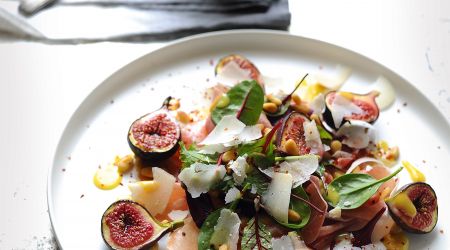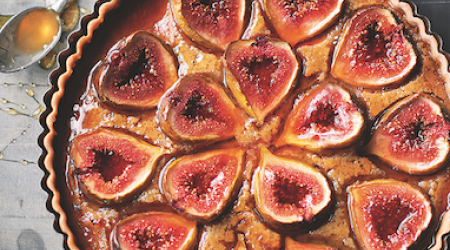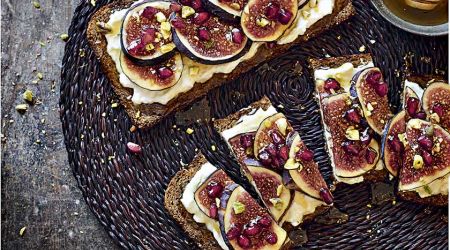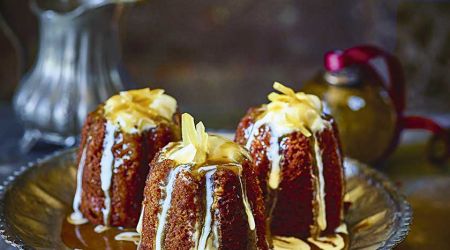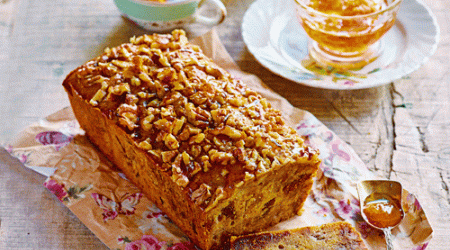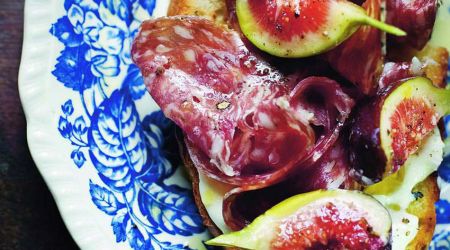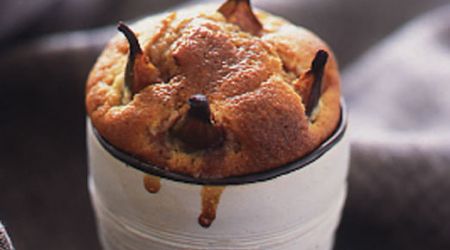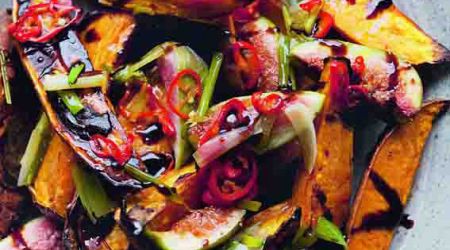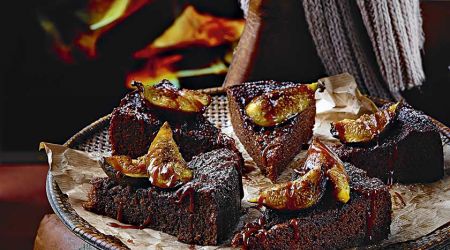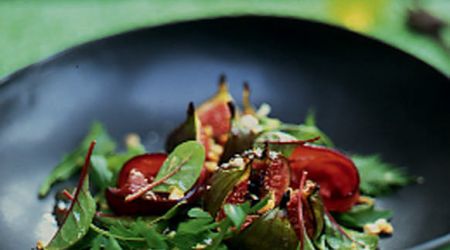Figs
Summer’s finest offerings, these decadently honeyed earthly joys are equally at home in savoury as they are sweet dishes. One of the earliest fruit trees to be cultivated, they have been much fabled in literature and mythology alike. Clarissa Hyman takes a bite
The first taste of a ripe fig plucked straight from a sun-warmed tree is a moment that you never forget. Figs fill the mouth with sweetness. They are the most sensual of fruits and, at the peak of their lush ripeness, have an incomparable fragrance and texture. Figs are also edible history and, like olive trees and vine, celebrate the timeless essence of the Mediterranean.
Figs are seldom labelled by variety. Instead they are classified and sold typically by colour: white, green, black and red/brown. The full spectrum can range from luminous pale green to dark gold, copper-brown or deep purple-black. The honeyed flesh may be pale pink, deep red or any blushing shade in between. Their internal structure is complex, as Aristotle noted in the 4th century BC. Botanically, each fig is actually a flower, which blooms inwardly and contains around 1,500 tiny blossoms. Some varieties self-pollinate, while other varieties rely on a symbiotic relationship with the fig wasp. While most commonly found in the Mediterranean, types of Ficus are noted across the globe.
The yellow-green Italian Dottato (or Kadota) fig, with amber-pink flesh, is one of the most widely grown. They are often canned in heavy syrup, needing a dollop of vanilla ice-cream, crème fraîche or Greek yoghurt to temper their squashy sweetness. Another Italian variety called Verdone (or White Adriatic in the US) has light green skin and strawberry-pink flesh and is perfect for both eating and preserving. Black Mission is a famous variety introduced into California in the 18th century from Mexico via Franciscan monks and Spanish missionaries. They have thin, black-purple skin and rather coarse, watermelon-pink pulp loaded with minute seeds and a rich, sweet flavour. When dried, the small figs take on an addictive, moist, chewy quality. Brown Turkey, an equally renowned variety, has meaty, soft red flesh, purple-brown skin and a wonderful flavour.
One of the foods of the Bible, figs were said to grow in the Garden of Eden. Their edible leaves were supposedly used to cover the nakedness of Adam and Eve, which might make the fig leaf the first item of clothing in history. At the original Olympics, athletes were crowned with wreathes made from fig leaves, and would eat the fruits during their training. The Romans, too, honoured the fig tree, believing Romulus and Remus were suckled under one. They also prized figs from Izmir, in Asia Minor, where the plump and golden Smyrna variety is still commonly grown.
In fig-growing regions the season stretches from June to October or even November. When buying (or better still, picking), select those that are unblemished, feel heavy in the hand and seem almost on the point of bursting. The fruit should have a slight bloom and a few tell-tale beads of honey at the stem.
Due to their delicate nature, ripe figs require careful handling. Easily bruised, they are often packed in tissue paper.
They might last a few days in the fridge, although chilling can spoil their delicate flavour. For convenience, however, many figs are imported hard and immature; try keeping them at room temperature until the skin softens, and then bring out their delightful scent and flavour by leaving them in the sun as long as possible.
Perfectly fresh figs are perhaps best eaten simply as a dessert or a starter with Parma ham or prosciutto. A pretty way of serving them fresh is to cut them into wedges almost to the base and press gently up into a flower shape to elevate a simple cheeseboard – salty cheese balances out their richness. Or poach them whole or halved in spiced syrup, wine or honey. Cooking figs brings out all their glorious jamminess – bake and stew for sauces or try sweet and savoury dishes such as tarts or roasted duck or quail with figs. Any leftovers from a seasonal glut are ideal fodder for chutneys.
Versatile and intensely flavoured, fig can hold its own with plenty of other strong ingredients. Jason Atherton drizzles his with truffle honey alongside burrata for a fresh, heady starter, while Marcus Wareing champions figs alongside gamey meat. Nathan Outlaw pairs his with hazelnut and ale in a moist, fruity cake and both Galton Blackiston and Margot Henderson put often-forgotten fig leaves, with their tropical coconut and walnut notes, front and centre in their ice creams.
Dried figs are made from the very ripe fruits from late in the season. The best are sprawled out to dry in the sun, turned several times so they flatten out and are loosely packed together to remain plump. Sometimes you find them strung together like a necklace. Eat them as they are or stuff them with marzipan or cream cheese, use them in compotes, in tea breads and cakes or stewed, flavoured with anise and fennel. Figgy pudding is a steamed British pudding that's traditionally served on Palm Sunday, although now more associated with Christmas. New Year sees the South of France tuck into a mixture of dried figs, raisins, hazelnuts and almonds to commemorate the colours of the four Catholic mendicant orders.
Figs may be equated with worthlessness in popular expression, but it’s a rather curious metaphor. To understand their true, romantic value, you need to eat them ripe from the tree at dawn before the sun touches them. Only then can you fully appreciate Elizabeth David's statement that they are ‘one of the exquisite pleasures of the Mediterranean’.
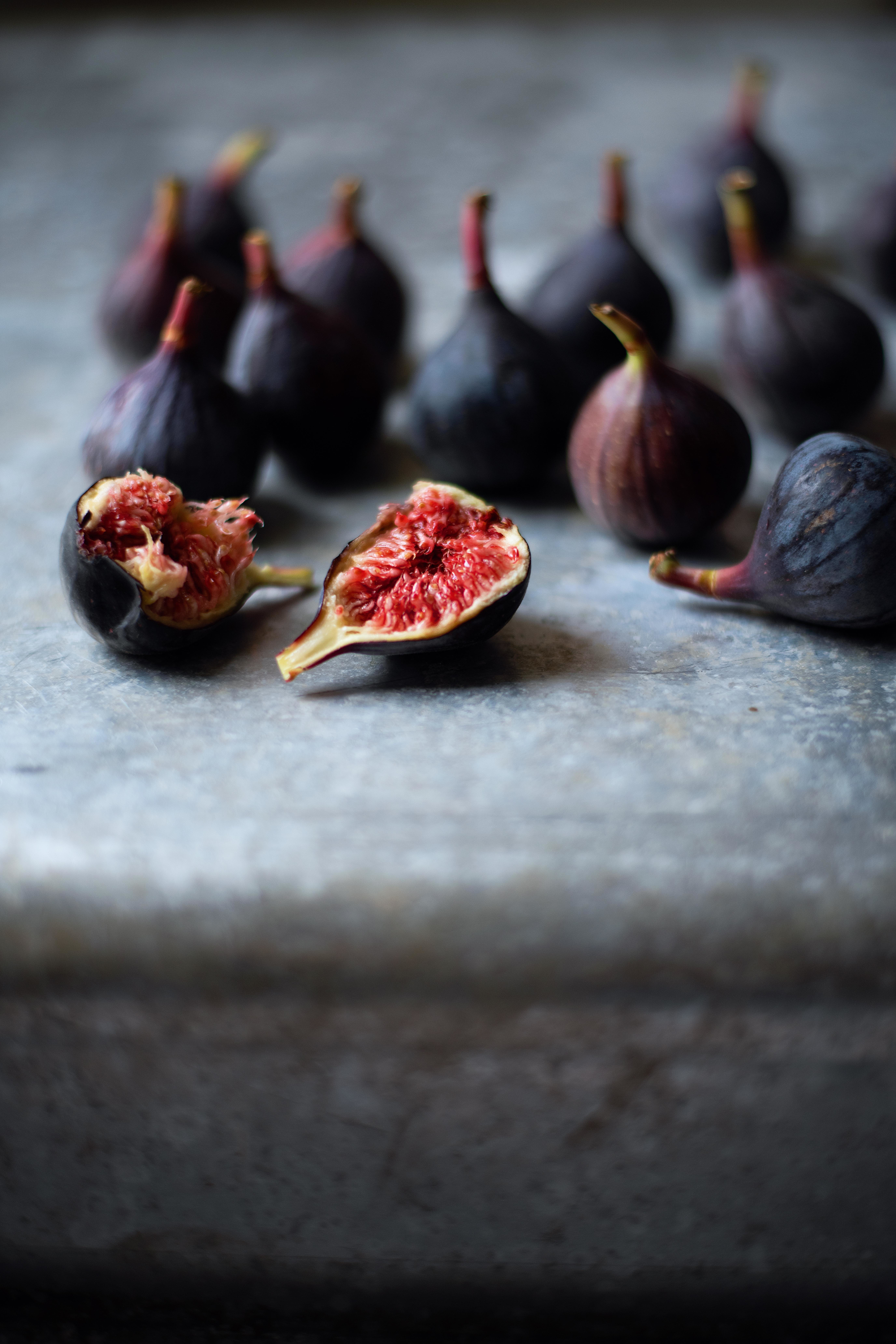
Recipes
Get Premium access to all the latest content online
Subscribe and view full print editions online... Subscribe



